Last year amid all the ceremony that surrounded the centenary of the 1916 Rising I set about researching some of the family history around that hugely significant event. I did of course throw in a bit about politics, football and a few other things and the resulting effort can be found here. That article had tended to focus more on the Kieran family; the family of my grandmother and some of their connections to the town of Dundalk.
The post was well received and seemed to be of special interest to family members as it jogged some recollections of long dead aunts and uncles, of half forgotten stories and the other various myths and tales that are told in all families. I was however admonished for not focusing enough on the Farrell side of the clan, after all theirs was a story worthy of telling as well. I’ve duly started to compile some information on the Farrell side of the family from around the same period (turn of the 20th Century) and the results compiled below.
But first back to the Kieran family! In the previous post I touched on the lives of Thomas Kieran and Jane Brennan, my great-grandparents. Thomas as mentioned had been born in Dundalk around 1889 and worked as an engine fitter at the Great Northern Railroad in Dundalk before moving to Dublin where he continued working as an engineer for the railways. He married Jane Brennan of Dominick Street in late 1915. Jane was born around 1891 to Jane and John Brennan.
Tom and Jane lived at 27 Blessington Street in the north inner city. As mentioned in the previous post Tom had been involved with the Volunteers during the Rising in Dundalk and he maintained his republican interests while living in Dublin. On the evening of 16th December 1920, Tom was arrested at his residence in Blessington Street and the house was thoroughly searched for weapons though none were found. The arresting officer was one Lieutenant Percy Gerald Humfrey, who noted that upon being arrested Tom said nothing at all.
He wasn’t the only family member to be arrested around this time as I discovered tracing back the Farrell line. For reference here’s the basic family tree below because this can get a little complicated.
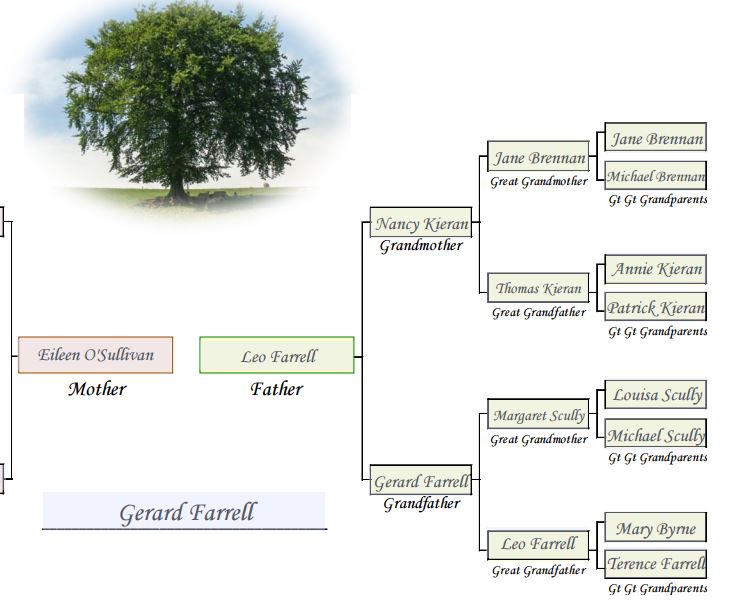
Let’s being with my great-grandfather Leo Farrell (who my Da is named after), he was born in early 1893, one of eight children that survived (there were ten born in total) to Terence Bellew McManus Farrell and Mary Farrell (nee Byrne). Leo was a railway engineer who worked in the CIE yards in Inchicore and was also an active Trade Union member with the Irish Engineering and Foundry Workers Union among others. He was also quite an athlete in his younger days, he was a member of Clonliffe Harriers running club. I’ve recently found a reference to Leo winning a one-mile race for Clonliffe Harriers back in 1911 when he would have been around 18. There is a short report on the race from the Dublin Daily Express (below) showing Leo comfortably finishing the race in a sub 5 minute time. My Dad remembered him as a kind and generous man, who despite his athletic past was short and rotund with a big appetite.

Irish Engineering & Foundry Union Rules Revision Conference 1936 – Leo Farrell is in the front row second from the left. Photo provided to me by the TEEU.
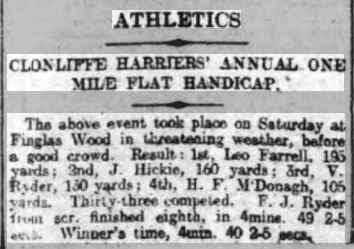
Report in the Dublin Daily Express from 6th November 1911
Leo’s younger brother Terence Patrick Farrell was born in late 1898. The younger Terence is quite an interesting character and it was he who was also arrested in December 1920, the same time as Thomas Kieran and from very close by too. Terence had grown up in the family home on Anne Street North, just off the city’s north quays near to the markets area however, the family later moved to 32 Mountjoy Street, just around the corner from Blessington Street where the Kieran’s lived.
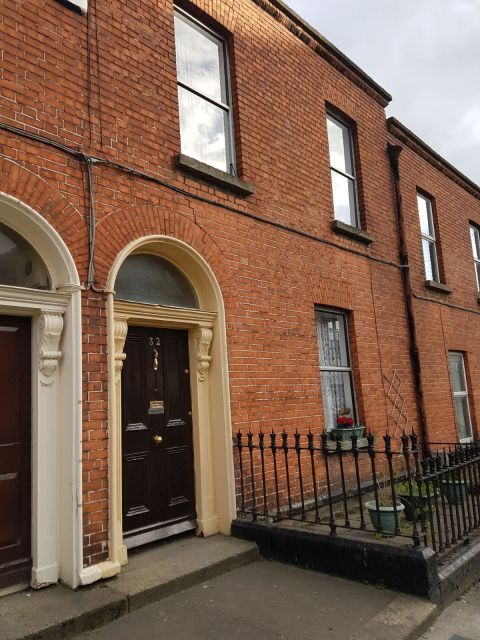
32 Mountjoy Street as it appears today.
Terence became involved with the Republic movement even before the Rising, while still a teenager he joined Fianna Eireann and turned up at Jacob’s biscuit factory as part of E company of the 2nd Battalion of the Dublin Brigade during Easter week. However, he was only there for a few hours before being sent home due to his age (he could only have been 17 at the latest).
Terence rejoined E company of the 2nd Battalion in early 1917 and attended the various parades and drills required of an IRA member. By 1919 he had undertaken a first aid training course and was performing training classes for Cumann na mBan members once or twice a week in Finglas as well as in Summer Street just off Mountjoy Square.
Later in 1920 Terence was involved in an aborted rescue attempt for the recently arrested Kevin Barry. Interestingly Terence noted that it was a cousin of his (a family story was that this was his cousin Rosie McGrane who smuggled Terence’s revolver out of 32 Mountjoy Square when he was arrested so it may she may have also been involved with the Republican movement) who mobilised him for a the rescue attempt. He was armed with a gun and grenades and stationed at North Great George’s Street in what would have been a last-ditch, desperate attempt to liberate Barry from Mountjoy prison. Due to the large crowds gathering outside the prison and the growing number of military personnel that were stationed there it was decided due to the expected carnage that would ensue that the rescue attempt would have to be called off. Kevin Barry was later executed by hanging.

A view from the spot on North Great George’s Street where Terence was stationed for the Kevin Barry rescue attempt
Undoubtedly the most significant incident in which Terence was involved was his role during Bloody Sunday, 21st November 1920. He was one of the lookouts at the 22 Lower Mount Street where Lieutenant Henry James Angliss and Lieutenant Charles Peel were residing. Angliss, who was going by the code name Peter Mahon/McMahon, was a particular target due to his involvement in the murder of Sinn Fein Councillor John Lynch at the Exchange Hotel on Parliament Street in September 1920.
While Angliss was killed on Bloody Sunday, Peel managed to escape a similar fate by barricading himself in his room. Terence was keeping guard in the hall when some passing Auxiliaries were alerted by the screams of the housemaids, the Volunteers tried to escape from the back of the house but came under fire and they had to fight their way out through the front. Terence was armed with a pair of revolvers and helped cover the group, expending all his ammunition as the rest of the party made their escape up Grattan Street, helping the injured Volunteer Denis Begley to escaper with him. In a letter written years later supporting Terence’s military pension application Begley stated that Terence by his
action in entering the house to give the alarm at Lower Mount St. on that morning, is, I think, worthy of great commendation, being carried out under fire from the “Auxiliaries”, and was the means, no doubt, of saving the lives of the party of of eight Volunteers who were inside the house.
There is a wider account of the assassination here. Terence continued in other activities including the armed raid of the SS Clarecastle, a Guinness ship that was being used to transport weapons. The volunteers were successful in seizing arms from the ship. This must have occurred some time in 1918/1919 when many of the Guinness ships were under the control of the Royal Navy who had commandeered them after the outbreak of World War I, only returning them to the brewery in 1919.
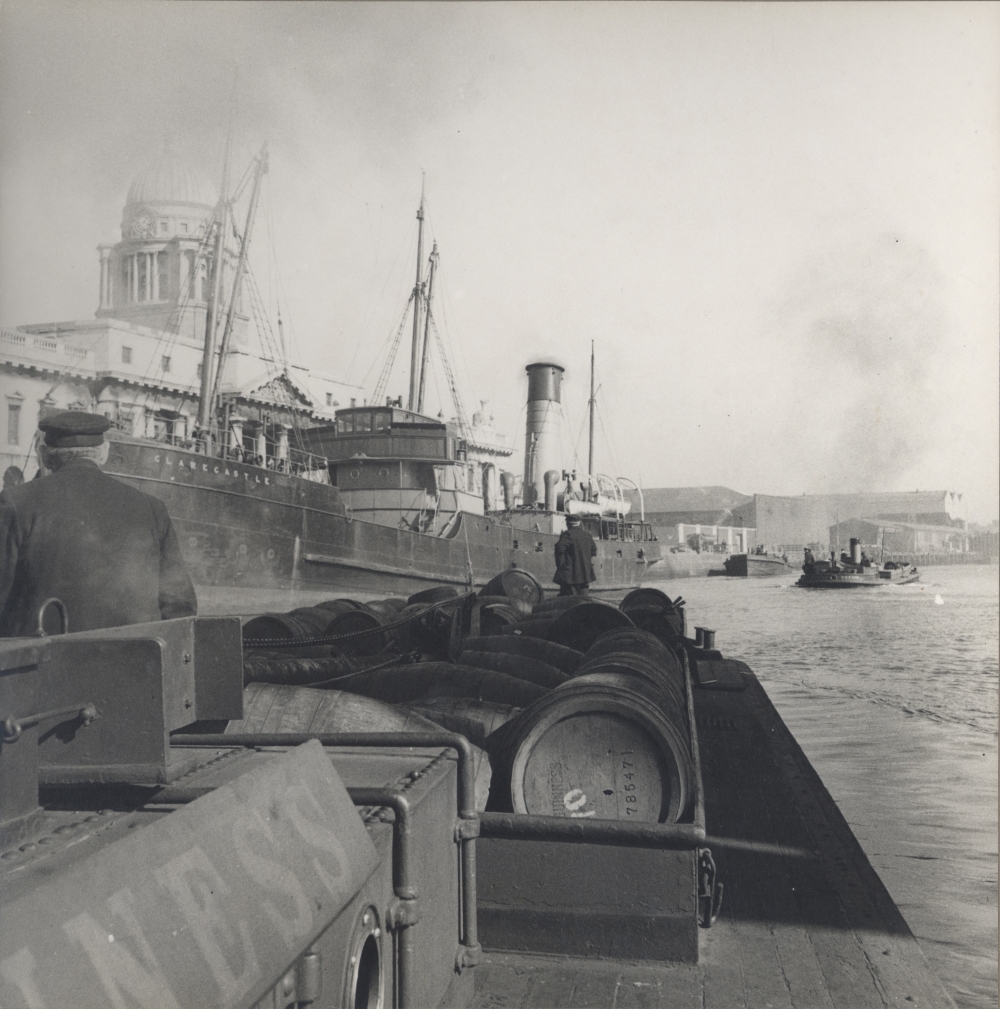
A view of the SS Clarecastle in front of Custom House Quay. Photo kindly provided by the Guinness Archives
Terence was arrested in early December 1920 at the family home at 32 Mountjoy Street. He was held in Ballykinlar, Co. Down, an army base turning internment camp, and was not released until December 1921. Terence’s autograph book which he kept during his imprisonment is held in the National Library’s microfilm collection.
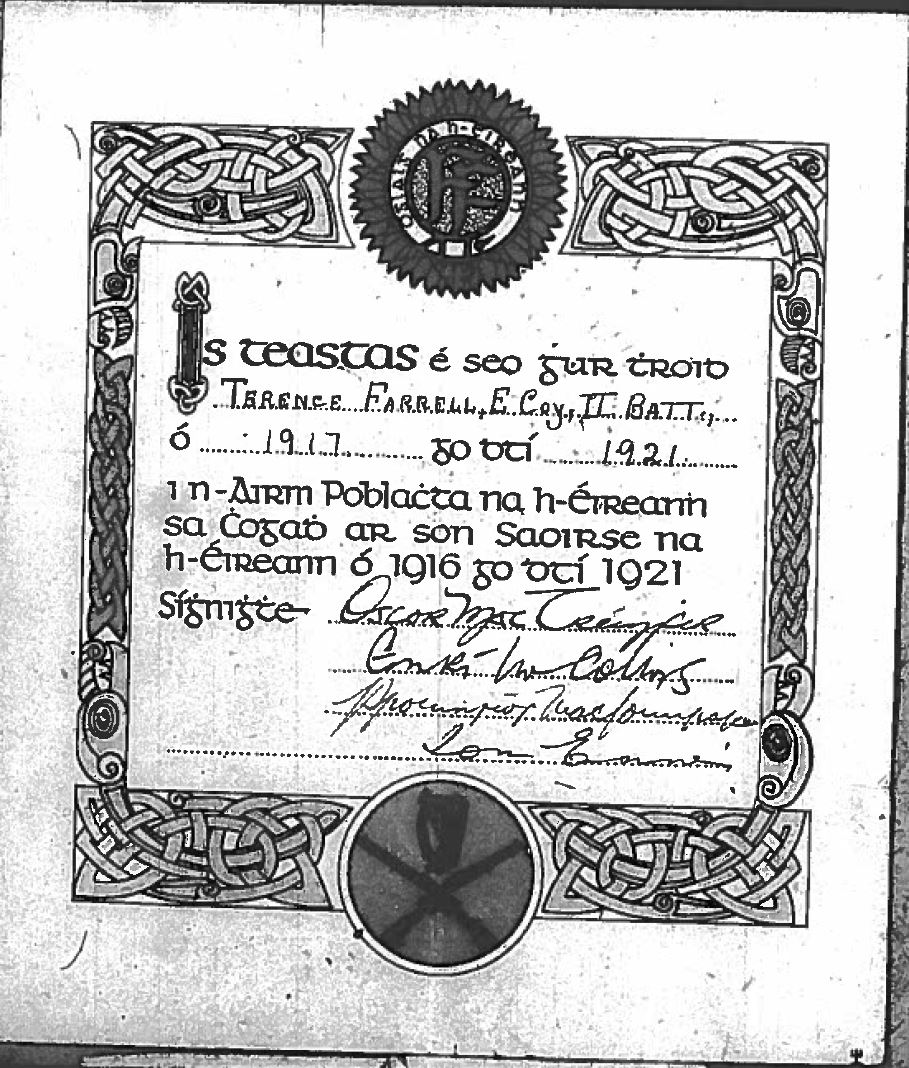
Certificate showing Terence’s membership of the IRA, signed by Oscar Traynor
After his release he had a varied and full existence. He was heavily involved in the Trade Union movement. Terence like his father Terence Snr. was a bookbinder by trade and he soon became head of the bookbinders Union. Through his leadership of the bookbinders union he became more prominent in the Trade Union movement, later becoming the last President of the Congress of Irish Unions (CIU), one of the main Trade Union confederations before their amalgamation which led to the creation of ICTU. Terence represented the CIU at the 1958 International Labour Conference in Geneva where he spoke about the importance “educational activity in the field of labour – management relations”, Terence remained active with ICTU and was one of the party who attended the new organisation’s first meeting with then Taoiseach Sean Lemass. Among his other work was a role representing the Trade Union movement on a government committee set up to advise on the establishment of a national television station in 1958, two years before RTE Television was established.
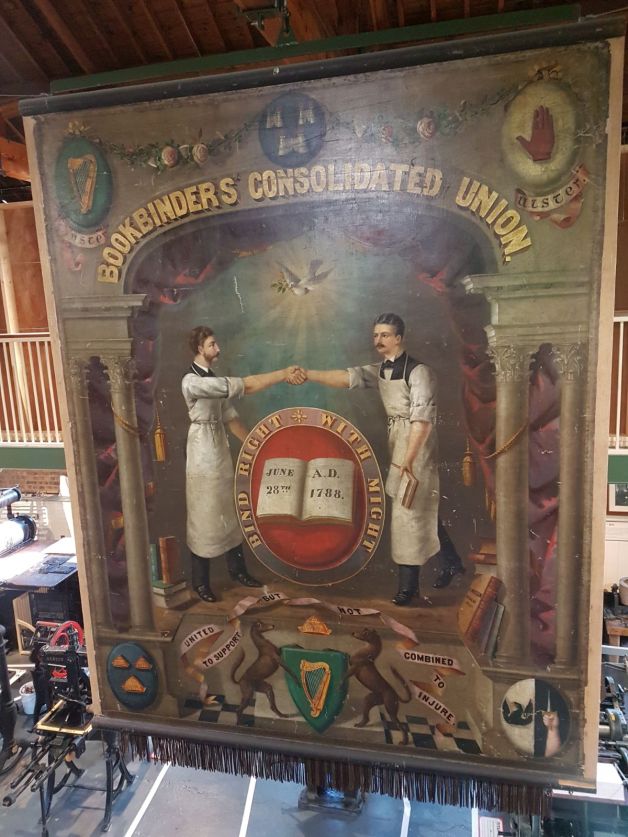
The banner of the Bookbinders Union made in 1887 and no doubt very familiar to Terence O’Farrell who led the Union and his father who was also a member. The banner is displayed in the Irish Print Museum.
Terence didn’t live quite long enough to see the first television broadcast of the new station on New Year’s Eve 1961, he had passed away in February of that year. The chief mourners at the funeral were his wife Elsie and and his six children. His brothers and sisters were also in attendance as were Taoiseach Sean Lemass and Minister for Justice Oscar Traynor who had known Terence from his days in the IRA. He was accorded full military honours at his funeral.
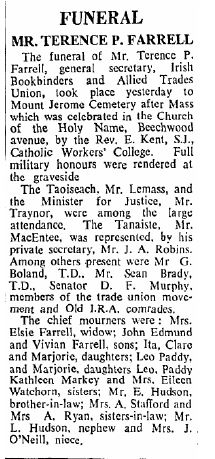
Terence’s father Terence Farrell Snr. who was briefly mentioned above was also a printer by trade which gives us a hint how the younger Terence ended up becoming general secretary of the bookbinders union. He was born in May 1864 in Faithful Place to Patrick and Catherine Farrell. Patrick was a wine barrel cooper while we don’t know if Catherine Farrell (nee Brady) had a job outside the home as this wasn’t recorded at the time.

Birth certificate of Terence Farrell Senior
The area where Terence Snr. was born is mentioned as 12 Faithful Place which no longer exists today. However in 1864 it was located in a the area marked by the red “x” in the centre of the map below on an area now just off Railway Street currently by City Council social housing complexes.

Map of the area around Faithful Place. Lower Gardiner Street is visible to the left.
By the end of the 19th Century this area had become synonymous with vice and prostitution, it was the infamous “Monto” area, named after nearby Montgomery Street (now Foley Street), and was the “Night Town” of James Joyce’s Ulysses, however, around the time of Terence’s birth it had not quite become the red light district of the city, only becoming a focal point from the 1870’s onwards. While perhaps not as infamous as it would later become it was a far from wealthy area, the photo below shows the condition of Faithful Place in 1913. While the area had originally been developed by the Gardiner family who had laid out and developed Mountjoy Square as one of Dublin’s finest addresses the area had declined in the early decades of the 19th century leading to the once opulent Georgian houses becoming tenements for the city’s struggling working classes.
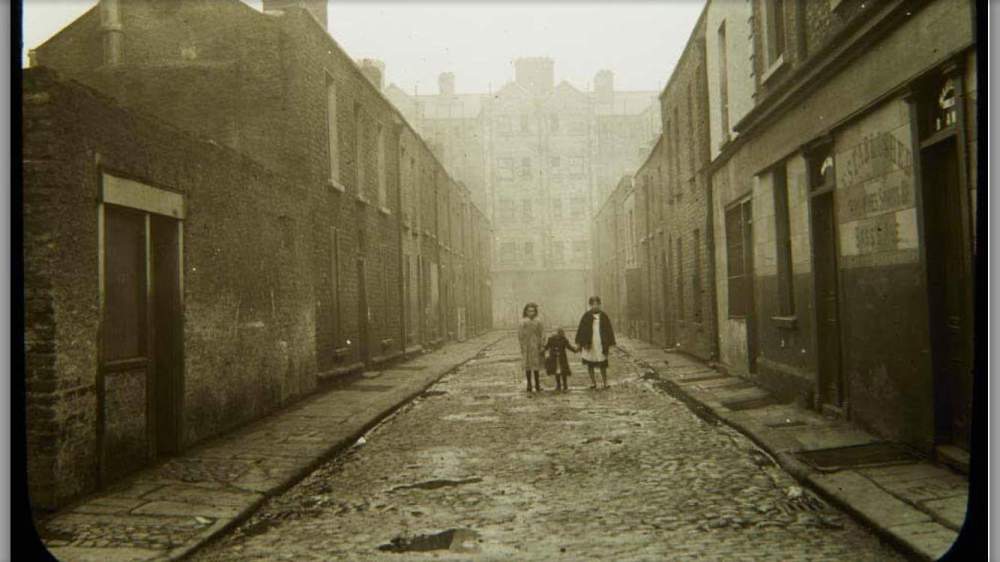
Faithful Place in 1913 (source http://www.census.nationalarchives.ie)
While Terence would go on to have a certain distant connection to the literary world of Dublin as he worked as a bookbinder but we know less of his parents Patrick and Catherine Farrell, they seem to have been married in April of 1843 in St. Andrew’s Church on Westland Row. Their fate is a little less certain so if anyone comes across any other information on them please let me know.
I’d like to finish with a little bit on the Scully side of the family. Leo Farrell married Margaret Scully in 1916. Leo would have been 23 at this stage while Margaret would have been about 20 years old. Margaret was the daughter of Louisa and Michael Scully who lived in rooms in 70 Benburb Street in Dublin 7. Michael was born around 1869 and was listed as a general labourer. He died at the young age of only 30 on St. Stephen’s Day 1899 with the cause of death listed as pneumonia and heart failure, only two months earlier they had registered the birth of their baby daughter, also named Louisa. In the 1901 census Louisa Scully (nee Gavigan) had moved a short distance from Benburb Street, across the river to nearby Watling Street. She had been a widow almost two years by that stage and worked as a laundress supporting her four daughters; Mary Ellen 15, Bridget 12, Margaret 7, and baby Louisa not yet 2.
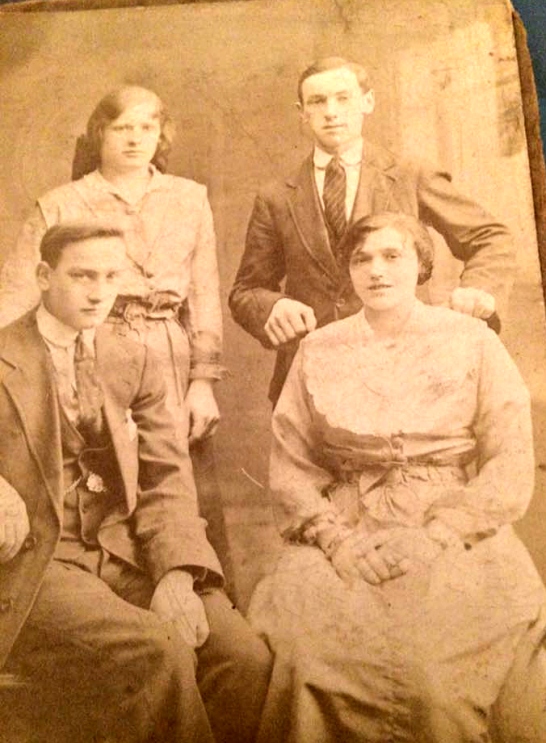
Seated in front, Leo Farrell & Margaret Scully on their wedding day in August 1916. At the rear is Margaret’s sister Louisa Scully (aka Francie) and Terence Farrell. Thanks to my cousin Lisa Taylor for the photo.
Although Louisa could neither read nor write she was listed on the 1901 census as being able to speak both English and Irish, her place of birth was listed as Kildare. Recently, I was shown a copy of her baptism cert and this lists her as being baptised in Celbridge, Co. Kildare in December of 1858. All her daughters were still in school and were literate. In the later 1911 census Margaret is the only daughter listed as being able to speak Irish as well as English, then in her later teens she was working as a shirt maker. This connection with the textile industries is something that was obviously passed on to her children, her older sister Bridget also listed her job as “ladies tailoring”, and there has long been a certain fashion and tailoring connection in the family.
While in the 1901 census the family were all listed as Roman Catholic by 1911 all or Louisa’s daughters listed under the religion heading their devotion to the Roman Catholic sodality of the Sacred Thirst. This was part of the wider temperance movement at the time and was based in Father Matthew Hall on Church Street, the family were at this time living nearby at 144 North King Street. There was widespread interest in these Church led campaigns against drinking beginning in the 1880’s, especially in the working class communities of Dublin. There is some more information about the hall and the sodality here. I have wondered whether the death of their father Michael at the age of 30 might have had an impact on the girls and their devotion to the temperance movement. Deaths listed as pneumonia and heart disease (Michael’s listed cause of death) were often the result of alcohol abuse, might this be have been the root cause for their devotion?
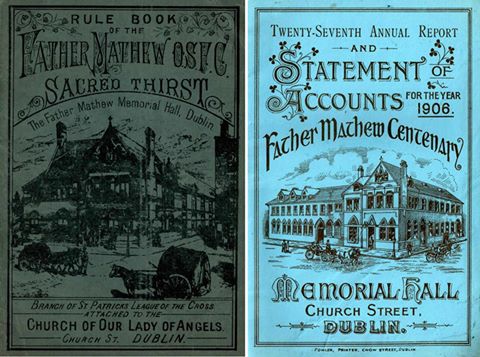
Publications by the Sacred Thirst sodality based in Fr. Mathew Hall on Church Street.
I’m ending this particular chapter of the familial research in a familiar address, 15 Fassaugh Road. A location known to all the family, it was where Louisa Scully Sr. passed away on the 1st of July 1938. She was 72 years old and had at that stage been a widow for more than 40 years. Her causes of death were listed as senility and cardiac arrest, with the witness on her death certificate being her son-in-law Leo.
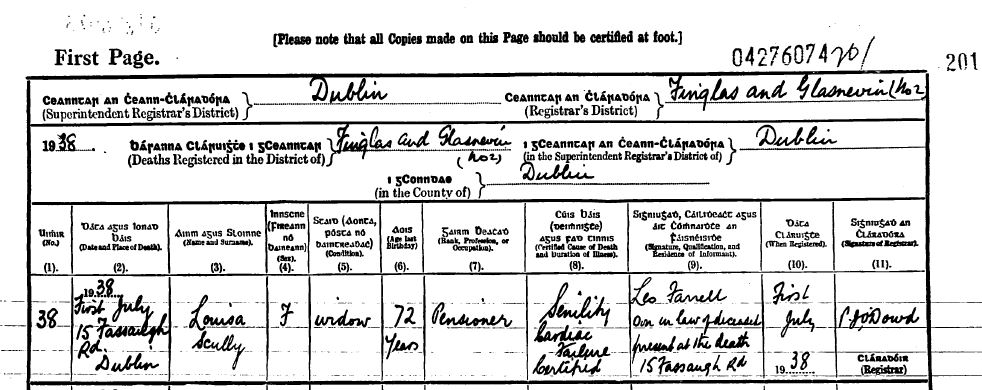
As with any family history there is always more to be told. Please let me know if I’ve missed out on anything, it certainly won’t be the end of my research. A big thank you to my second cousin, once removed Helen Farrell for all her assistance, her existing research has opened a lot of doors for me. Anyway I’m proud to be a ninth generation Dubliner, who knows what else we’ll find!

Brilliant read mammy really enjoyed it – in relation to your granddad Leo he was the president of the Irish engineering and foundery union – he also sat on the labour court (Mam thinks the very first one) Sean lemass also attended he funeral. Re rose mcgrane always interested find the connection – looks like was a niece of mams great granny Jane mcgrane ? I remember roses funeral and she had a full military funeral as well . Mam has a story that she was bringing a sick baby to temple street in a pram so she could smuggle arms during the curfew. Mam will have more info to give you if you ring her some afternoon r evening
LikeLike
Thanks Lisa, I’d heard the story of the baby in the pram before. Trying to find more about Rose, she sounds like an interesting character. I’ve also been in touch with the Unions to which have all amalgamated now and also Clonliffe Harriers to see if they have a record of Leo. I’ll update the piece about the engineering union.
LikeLike
Louisa scully on 1901 census was gavigan not garagan
LikeLike
Fascinating read Gerry. Some additional parts that my side of the clan weren’t aware of. Thank you!
My father is Edwin, Terence’s eldest son (listed as Edmund in the death notice) who lived at 18 Elm Park Ave, Ranelagh with Terence & Elsie.
LikeLiked by 1 person
My Terence Farrell was born 1823( approximately) Kildare parents were Terence Farrell @ann halfpenny are they related at all to you ? Have been trying for a while not getting far
LikeLike
As my old dad used to say, ‘us Farrell’s get everywhere’. Apparently my father Norman Joseph Patrick Farrell, was born at Ballyogan Road, Kilternan in 1931. He had brothers, Frank, Dermot and Brian and a sister Yvonne. I believe only Dermot is alive now. My dad came to England in 1940 aged 9.
LikeLike